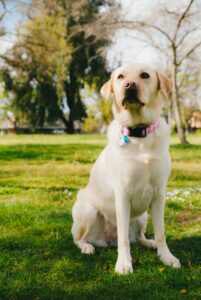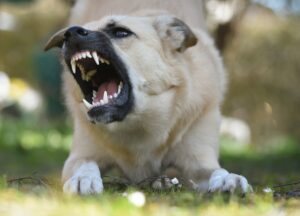When we think of a dangerous dog, images of a ferocious wolf or a large breed dog of some kind come to mind. But the truth is, any dog breed has the potential to become ‘dangerous’ if they are not socialised and trained properly from an early age.
No animal is inherently evil or dangerous – their behaviour is based on the way we treat them and how we train them. If you have made the decision to add a dog to your home it is crucial that you understand what makes dogs dangerous to keep yourself and others safe. While there are some inherent risks with having any type of animal in your home, learning about the potential dangers and difficulties associated with your specific breed of dog will help you prevent potential hazards and promote a more secure environment for everyone.
What makes a dog ‘dangerous’
According to the RSPCA, a dangerous dog is “A dog that aggressively attacks a person or other animal, causing physical injury or death”.
Dogs of any breed or size have the potential to be dangerous, and the RSPCA believes “that dogs should not be declared dangerous on the basis of breed, but on the basis of their behaviour”.
An example of this was highlighted in a recent article from the ABC that declared Labradors as now being listed among the most dangerous dog breeds on the Gold Coast. The Labrador Retriever is one of the most popular and loved dog breeds in the world, so this finding will certainly come as a shock to many Labrador owners. However, this finding is mainly due to them being a large, strong and confident breed and is attributed to early socialisation issues and lack of appropriate training.
In most cases of aggression in dogs, they are simply trying to communicate with their owners by barking or growling. When dogs bite, it’s often because they feel threatened or defensive in some way. Dogs are dangerous when they aren’t socialised properly and are left unrestrained in a home or yard. As puppies, it’s important to begin socialisation training right away. This means taking your dog to public places, introducing them to a variety of people and environments, and letting them interact with other dogs. It’s also important to properly train your dog so they understand how to behave around other people and animals.
What Should You Know About Dog Breeds Before Buying One?
First and foremost, it is important to understand that owning any dog is a responsibility – one that you need to be prepared to undertake. This is not just about taking care of the pet itself, but also includes taking care of any mess it may make, any potential damage it may cause and dealing with any behavioural issues it may have.
As mentioned above, even dogs such as Labrador Retrievers who have a reputation for being sweet, loving and easy to train, have the potential to become dangerous. However, some breeds may be more genetically inclined to become aggressive and develop problematic behaviours, and this should be taken into account when selecting the breed that is most appropriate for you and your family.
Owners must accept full responsibility for their pets by ensuring they are properly trained and socialised from an early age to prevent them from becoming dangerous and potentially harmful to you and your family, other dogs and the community.
Aggression in Dogs
Contrary to popular belief, aggression in dog breeds such as Labradors is not as rare as many people think. As with any dog breed, aggression can be linked to genetics and can be triggered by certain environmental factors. It is important to be aware of the warning signs of potential aggression in your dog and to seek appropriate help if you believe that your pet may pose a danger to you or your family.
aggression can be linked to genetics and can be triggered by certain environmental factors. It is important to be aware of the warning signs of potential aggression in your dog and to seek appropriate help if you believe that your pet may pose a danger to you or your family.
Some common forms of aggression in dogs can include:
- Marked Territorial Aggression – This is where a dog will aggressively defend its house or yard against other people, by barking, growling, snarling or biting.
- Fearful or Defensive Aggression – This occurs when a dog feels threatened and is either unable or unwilling to back down. Such aggression may be directed towards people, other animals or even inanimate objects. Signs of this type of aggression may include a fearful body posture with hair raised or tail and ears down and an overall rigid body language.
- Sexual Aggression – This is very common in male dogs and is most often directed towards other male dogs. Females can sometimes be aggressive towards males as well.
Dogs that are not desexed are more likely to become aggressive as they have higher levels of testosterone. Other factors that can also contribute to aggression include poor socialisation, poor nutrition, and lack of mental stimulation.
Treatment and management of aggression and problem behaviours
It is possible to treat and manage aggression and problem behaviours in your dog. There are many reasons behind animal aggression and it’s important to find out the cause. This can help you come up with a way to prevent it from becoming a bigger problem.
Dogs are pack animals and have a natural instinct to protect their territory and loved ones. Even dogs that have been properly trained and socialised may begin to demonstrate the instinct to protect you and your family in an aggressive way. If your dog is biting or growling at a person, it’s important to find out why. Dogs are often born with the ability to guard, but it is up to each owner to teach them how and when to use this skill. From an early age, you can train your dog to know when they are supposed to be protective and when they should not act this way. You have to be firm and consistent in your training, and all members of your household must follow the rules when interacting with your dog.
A veterinarian or dog behavioural specialist can help you to identify the triggers that provoke aggressive and protective behaviour, and create a treatment and management plan to help you to improve your dog’s behaviour in both the short and longer-term.
Dogs can be wonderful companions, but it’s important to understand what makes dogs dangerous so that you can keep yourself and others safe. It’s important to provide dogs with proper training, nutrition, exercise and mental stimulation to ensure that they don’t become aggressive or bored.
The truth is that all dog breeds have the potential to become dangerous, even the so-called “safe” breeds. Every dog is an individual, and each has its own unique personality and quirks. It’s up to you as the owner to provide a safe and loving home for your furry friend, and it all starts with proper research and selection.